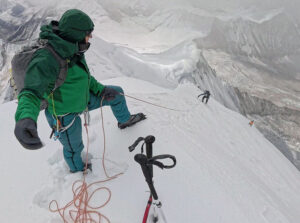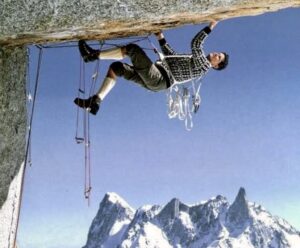Is it possible for commercial and independent teams to coexist peacefully on the normal 8,000m routes?
In two weeks, the autumn expeditions in the Himalaya will begin on Dhaulagiri and Manaslu. Agencies are getting ready, offering VVIP services to their clients. Mass transfer by helicopter of mountaineers to base camps, full service, one Sherpa per climber, an army of rope fixers, porters carrying loads, hotels, luxury tents, 12 bottles of O2 per client, two sets of oxygen regulators, pampering in base camps and even high camps, tea, espresso…
All the client has to bring is fitness, a camera, and about $130,000. Then the “adventure” on the normal routes begins.

Stacked like ordnance, O2 bottles are ready for the helicopter shuttle to base camp and beyond. Photo: Tashi Sherpa
Independent teams will also show up. Currently, we are waiting for confirmation about who is going to the various 8,000m peaks. As usual, most will stick to the normal routes, but a few will try different ones. (We’ll do our roundup after Angela Benavides returns from vacation in about a week.)
For now, let’s consider the normal routes. In recent seasons, we’ve seen numerous conflicts, big and small, between commercial and traditionally independent teams on the same routes.

The swarm on the move. Photo: Mingma Dorchi Sherpa
Who is independent?
What exactly is an independent climber? If a team follows a well-broken trail and uses the fixed ropes of the commercial teams, are they really independent? Even if they don’t use oxygen, probably not.
But what if they decline to use all the advantages of a prepared route? Maybe they even arrive before anyone else. Can they avoid having to comply with the rules set by the commercial outfitters? Paying the outfitters a fee to be on that same route, for example?
Those who do not identify themselves as clients but go on the same routes as everyone else tend to think that they are different from commercial clients. But that’s a hard case to make. Some climbers claim to be independent but they use the fixed ropes. Others use the broken trail or have their own Sherpas. Even if they eschew all those things, they often still have to pay, because the commercial groups monopolize the mountain.

On Dhaulagiri: Stefi Troguet, Jonatan García, Carla Perez, and Esteban Mena. Photo: Jonatan Garcia
Conflicts on Dhaulagiri
Last spring, Spanish mountaineer Jonatan Garcia was on Dhaulagiri (8,167m). Remember how complicated everything became? COVID infected many people in Base Camp. Garcia returned home with a very bad taste in his mouth, not just because the pandemic had been rampant in Base Camp.
Garcia wanted to climb without Sherpas and without oxygen. When he and teammate Stefi Troguet of Andorra reached Dhaulagiri, they joined Carla Perez, Esteban Mena, and their photographer, Tommy Joyce.
They were the only five mountaineers with a plan to climb without supplementary O2 and Sherpas. They paid only for Base Camp service. The problem came when the clients and their outfitter arrived at the BC. Garcia described the situation in an interview that he later gave to Planet Mountain.
“I wanted to go up to C1 to get my things. But the head Sherpa of that company told us that we had to pay to leave BC…although we weren’t going to touch any rope. The Sherpas do not see the mountain, nor the customers. They only see the money. If you come to the BC paying only for the BC service, and an outfitter then comes to the mountain, exploits it, markets it, you are no longer welcome there. They told us: You five people who are without Sherpas have to pay $1,500 to set one foot out of BC.”
This won’t stop here
Garcia immediately decided that this atmosphere was not for him. “This trend won’t stop here,” he said. “It will continue until one day something happens.”
He also pointed out how on Annapurna, “a helicopter transported rope, food, gas, and oxygen to a high camp for the clients, and 67 people made it to the summit on the same day. There were also some climbers who were transported from C4 to BC by helicopter.”
Garcia returned home, lesson learned: In the future, he wanted no part of normal routes on the 8,000’ers.

Jonatan Garcia. Photo: Jonatan Garcia
Austrian David Goettler tried to climb Everest again this year, with famous Catalan trail runner and alpinist Kilian Jornet. Goettler’s last attempt was in 2019 when he had to turn around 100m from the top because of the large number of oxygen-sipping clients in a queue.
This year, he and Jornet reached the South Col by the normal route, without O2. Here, they finally decided to descend because they did not feel well enough.
David Goettler, who lives in Cantabria, Spain, gave an interview after the expedition with the newspaper El País:
I accept the Everest circus
“Of course, I am horrified by the queues [on] Everest, but I also do not understand queuing in the car in the heat of summer to go to the beach, something I have seen here for years. What I mean is that I do not feel entitled to tell anyone what to do or not…
“When I go to Mont Blanc, Matterhorn, Aneto, or Everest, I know there are going to be a lot of people. I assume it and do not raise hell. Behind the mountains, there is a business, and as a guide, I benefit from it. People want to consume mountains and they go unprepared.
“I accept the Everest circus. I am part of it. And only mountain culture education can resolve this, but unfortunately, I do not think we will succeed.”

David Goettler and Kilian Jornet on Everest. Photo: David Goettler
The 2013 riot
In 2013, Simone Moro, Ueli Steck, and Jon Griffith had a serious incident with Sherpas on Mount Everest en route to Camp 3. The three were climbing apart from the commercial groups. Moro said in an interview with National Geographic at the time:
“We knew there was a rope team fixing on the Lhotse Face…I know that on the day the ropes are fixed, nobody should hang on the fixed ropes. This does not mean that nobody is allowed to climb the mountain. Everest is not just for clients and guides. Everest is for all who pay the permit.”
Moro, Steck, and Griffith had no intention of disturbing the Sherpas or hanging on the fixed ropes. They were climbing alpine style, without a rope and parallel to the Sherpa team, 100m away.
After a while, they realized that their tent was on the other side of the fixed rope of the Nepalis, so they had to pass horizontally across it. This led to a tremendous blow-up later in C2. An angry group of Sherpas attacked them and threatened to kill them. Steck hid in his tent in fear, while Moro tried to appease the furious Nepalis.
Moro was kicked and hit. Such a horrible experience made them abort the expedition. Ueli Steck was traumatized. At the time, he vowed never to return to the Himalaya.

The 2013 incident. Screen capture of a video made by other climbers.
Despite this tension, Moro does not criticize the commercial style. Earlier this year, in an interview with Desnivel, he praised the first winter ascent of K2 by the 10 Nepalis.
“You can always evolve and there is always a place for better style and ethics,” he said. “The mountain must continue to be an oasis of freedom and respect for everything and everyone.”
Hard to be independent on normal 8,000m routes
Think back to the summer of 2019 on K2. Adrian Ballinger and Carla Perez summited without supplementary oxygen, supported by Gelje Pemba Sherpa, Palden Namgye Sherpa, and Esteban Mena (with O2). Were they really independent?
It depends on how we look it at. Did they join forces with Nirmal Purja and his team by happenstance, or were they waiting for Purja to break the trail for them? Ballinger and Perez used the ropes that Purja and company had fixed from C4 (7,950m) to the Bottleneck (8,400m). This made the final part of the summit push easier for the no-O2 pair.
There were no bad vibes or tension. However, in this case, we really can’t talk about the commercial and independent teams coexisting. No team was fully independent.

Adrian Ballinger climbs the Bottleneck on K2. . Photo: Esteban Mena
As we know, this last season on Broad Peak (8,047 m) was not free from controversy. Lotta Hintsa of Finland and her Canadian partner Don Bowie arrived at Base Camp long before the commercial groups. They fixed part of the route and climbed without O2, but could not make the final summit push.
That day, Hintsa wrote: “I get to C3, full of new climbers waiting to go up the next day. Don Bowie radios me and tells me that there is a high altitude porter [Mustapha] below C3 who needs help desperately. Because I was dehydrated, hungry, and had not slept in ages, I knew I was not the best option. I was trying to ask for help but everyone pretended they did not hear. So I packed my huge pack and started to go down. Belgian Jeff came after me and took over the rescue…I am down in BC, the masses are on their way to summit…”
Bad vibes or the thrill of solitude?
After the expedition, Hintsa reflected further about her experience: “I am pretty sure that I will not be climbing many normal routes in the future. Maybe for acclimatization, but the thrill I got climbing alone on the route for the first three weeks is something that cannot be felt on trafficked routes with ready-made infrastructure.”

Lotta Hintsa on Broad Peak Photo: Lotta Hintsa
The coexistence of commercial and independent teams on the normal 8,000m routes will continue to be difficult, as large groups spread to all the 8,000’ers. This spring’s Annapurna and Everest expeditions were highly successful, at least for the outfitters. Even K2 in winter was successful, despite the five deaths. As high-altitude tourism becomes even more of an industry, with more infrastructure, more support, and even higher chances of success, more clients will come.
Both types of mountaineering will coexist in the long run, but likely in different places rather than on the same route. The commercial interests will dominate the normal routes up the 14 biggest peaks — how can it be otherwise? — while the parties who value their independence will continue their exploration of new lines and remote mountains.

K2 on the left, Broad Peak on the right, and Skyang Kangri (7,545m) behind. Photo: Graham Zimmerman






